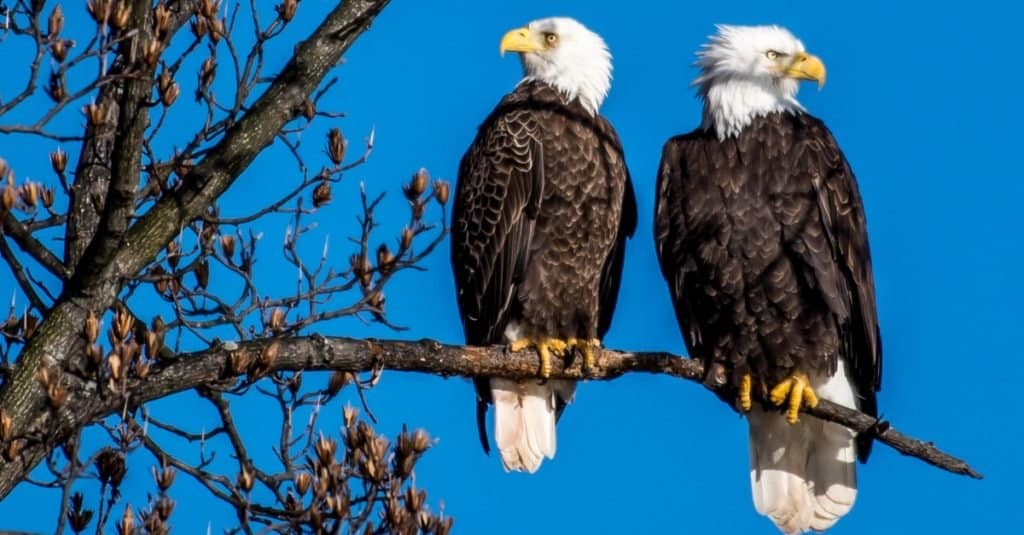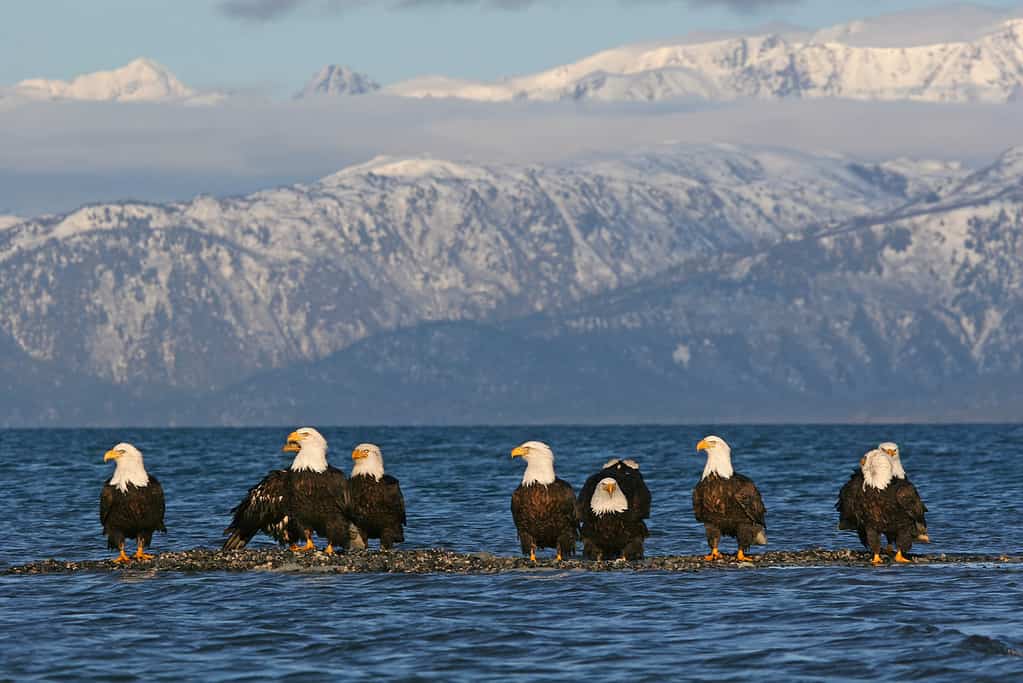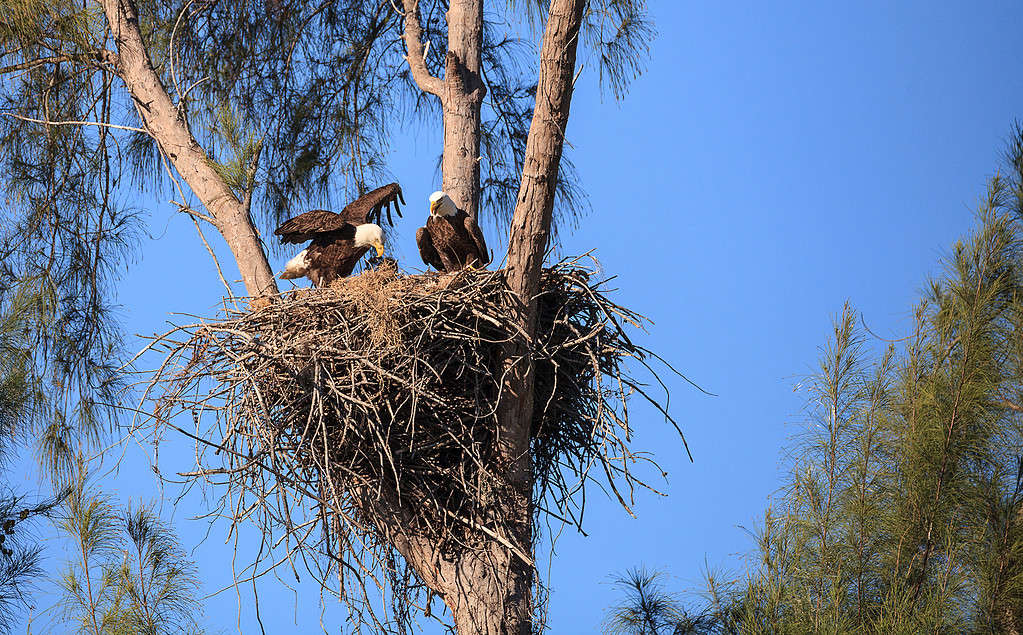The bald eagle (Haliaeetus leucocephalus) was designated as the national bird of the United States in 1782. This American symbol can be found in the skies of 49 states today. A handful of states have only migratory populations, but most have a year-round resident bald eagle population. Hawaii is the only state that has no bald eagles at any point during the year. While the remainder of U.S. states all host bald eagles, the number of eagles varies quite widely from state to state. How do the bald eagle’s numbers in Florida and Alaska compare? Both states have very healthy populations, but one is the clear and obvious winner.
Note: because bald eagles typically mate for life, the population is counted by breeding pairs.

Bald eagles typically mate for life, so they are counted as breeding pairs in state population surveys.
©Krumpelman Photography/Shutterstock.com
Alaska
Alaska has more bald eagles than any other U.S. state, and it isn’t even remotely close. The northernmost and largest U.S. state has an estimated 30,000 pairs of bald eagles. Minnesota has the second-largest bald eagle population of any state, with 9,800 pairs, highlighting just how much Alaska’s bald eagle population dwarfs the numbers seen in any other state.
Bald Eagle Bounty
The bald eagle wasn’t always welcome in Alaska, though. On the contrary, the raptors were once seen as a threat and were killed on sight. The government even placed a bounty on the eagle to incentivize Alaskans to kill more of the birds.
The Alaska Territorial Legislature offered fifty cents for every bald eagle that was killed beginning in 1917. That per-eagle bounty grew to two dollars by 1953 when the bounty ended. The government’s bounty program was largely offered to placate coastal fox farmers and salmon fishermen who saw the bald eagle as a threat to their livelihoods.
This seemed to contradict U.S. conservation efforts to protect bald eagles directly. Congress passed the Bald Eagle Protection Act in 1940, which made the killing of bald eagles a crime. The Alaskan bounty program was not in contravention of this congressional act, though, because Alaska was not yet part of the United States. Alaska would not gain statehood until 1959. By then, the bald eagle bounty program had ended.

Alaska’s bald eagle population far exceeds that of any other U.S. state, but these raptors weren’t always a welcome sight.
©iStock.com/Silfox
Alaska’s Booming Bald Eagle Population
Bald eagles are often found along Alaska’s coast and offshore islands. The highest density of bald eagles is found on the islands of Southeast Alaska. Bald eagles also nest near interior lakes and rivers. The Alaska Chilkat Bald Eagle Preserve in the southern reaches of the state is home to as many as 3,000 eagles in the fall and early winter as they gather to feed on spawned-out salmon.

These two bald eagles are confronting one another over access to post-spawn salmon in the Chilkat Bald Eagle Preserve.
©Richard Seeley/Shutterstock.com
Florida
While it is no match for Alaska, Florida has a healthy bald eagle population. With 1,500 breeding pairs, Florida has the fourth-highest population of bald eagles in the nation, behind Alaska, Minnesota, and Wisconsin. It was a very different story, though, just a few decades ago.
DDT
Florida’s bald eagle population suffered greatly, as did the entire U.S. population, from the proliferation of DDT (Dichloro-diphenyl-trichloroethane). This pesticide began gaining popularity in 1939, but its use skyrocketed when the United States entered World War II. DDT was used in theater to control the insects that carried typhus and malaria.
After the war, the chemical became widely used as a commercial and agricultural pesticide. DDT’s popularity was easy to explain: it was inexpensive, and it worked. Approximately 1,350,000,000 pounds of DDT was used in the United States in a roughly 30-year window.
Concern began to grow over the chemical’s persistence which, ironically, was one of its biggest initial selling points. DDT’s resistance to weakening over time allowed the chemical to enter the nation’s waterways. DDT was absorbed by fish and then by those animals that consumed the fish. This harmed few species more than the bald eagle.

DDT was a popular pesticide that ended up doing great harm to the reproduction of bald eagles.
©iStock.com/smartstock
Eagles Approaching Extinction?
After consuming contaminated fish, the DDT entered the bald eagle’s bloodstream, resulting in catastrophic results. The pesticide caused the shells of bald eagle eggs to become so fragile that they would break during incubation. It also caused many bald eagles to stop laying eggs altogether. Reproduction rates for bald eagles plummeted, bringing the species to a tipping point where extinction seemed to be a real possibility.
By the 1950s, just 10-15 years after DDT usage became widespread in the U.S., the nation’s bold eagle population dropped to around 1,000 birds. There were other factors at play, of course, but DDT was one of the chief reasons for the precipitous decline of the bald eagle.
The previously mentioned Bald Eagle Protection Act was passed in 1940. The bald eagle was further protected under federal endangered species law in 1969. But the biggest saving measure for the bald eagle was the banning of DDT in 1972. The following year, the bald eagle was listed in the Endangered Species Act of 1973.

This Florida bald eagle family can thrive now that the fish they consume are not contaminated with DDT.
©iStock.com/LagunaticPhoto
The Eagle’s Florida Comeback
The year of DDT’s ban was the same year the Florida Fish and Wildlife Conservation Commission began recording the nesting population of bald eagles in the state. In that first survey in 1972, the agency documented a mere 44 pairs of bald eagles. Many wondered if the pesticide ban and legislative actions would prove to be too little, too late. However, the bald eagle proved as resilient as the spirit of the nation it represents.
Today, Florida’s bald eagle population is more than 34 times greater than it was in the early 1970s.
The Bald Eagle’s Adaptability
It would be difficult to find two U.S. states with more disparate climates than Alaska and Florida, yet both states have thriving bald eagle populations. This is a testament to this raptor’s ability to adapt to different environments.
The reason the bald eagle has thrived in these very different states is because of one thing they actually have in common: both Alaska and Florida have plenty of water that teems with fish.
Fish are the primary prey for bald eagles. They can adapt to a frigid Alaskan winter as well as a sweltering Florida summer as long as they have ready access to fish.

Bald eagles flourish in Alaska and Florida because both states are filled with water that is brimming with fish.
©FloridaStock/Shutterstock.com
The Bald Eagle’s Future
There are 300,000 bald eagles in the United States today, and the number is continuing to rise. A 2021 report from the U.S. Fish and Wildlife Service (FWS) revealed the U.S. bald eagle population had quadrupled since 2009. FWS Deputy Director Martha Williams called the recovery of the bald eagle “one of the most well-known conservation success stories of all time.”
The comeback of America’s national bird has been so remarkable that the bald eagle was officially delisted as a threatened and endangered species on June 28, 2007. A mere 34 years after the species was listed in the Endangered Species Act and seemed a candidate for extinction, the bald eagle was removed as an endangered and threatened species. Deputy Director Williams was right. It is an amazing success story of U.S. conservationism.
Bald eagles continue to be protected under the Bald and Golden Eagle Protection Act and the Migratory Bird Treaty Act.
The photo featured at the top of this post is © Tony Campbell/Shutterstock.com
Thank you for reading! Have some feedback for us? Contact the AZ Animals editorial team.






